FOREWORD
Previous pandemics have reshaped societies in profound ways. The 1918 influenza pandemic changed the course of history – millions died and suffered, and many believed that the event was so severe and unique that it could never happen again.
In 2005, experts were alarmed at the emergence of the novel H5N1 avian influenza virus as it spread among wild and domestic birds in Europe and Asia. Although it rarely affected humans, when it did, it caused a very high mortality rate. The World Health Organization (WHO) warned that between 2-7.4 million people could die if an avian virus mutated to become a human pandemic (Cheng, 2005). This concern sparked active pandemic planning in many countries, national plans were developed and rehearsed, stand-by vaccine stocks were developed and some businesses invested in pandemic planning.
As everyone remembers, in 2009, an influenza pandemic struck – not from the expected H5N1 bird flu, but from a novel H1N1 virus. Because an ancestor of this virus had once circulated, some people had partial immunity to the new virus. The severity of this pandemic varied in populations and countries, but overall, its impact was far less severe than anticipated. After the pandemic subsided, a number of businesses who had developed earlier plans that focused on H5N1, relegated those plans to their archives, assuming that future pandemics would be equally mild and not disruptive to business continuity. However, experts, including this author in his book Business Continuity and the Pandemic Threat (2016), advised that businesses and business organizations should include pandemic planning in their business continuity plans.
Now we are facing the most severe pandemic experienced since 1918. On December 31, 2019, the detection of the SARS CoV-2 virus was initially reported to the WHO (WHO, 2020) and on January 9, 2020, the WHO announced the emergence of a novel coronavirus-related pneumonia in Wuhan, China (WHO, 2020). No one could have predicted how the emergence of this novel coronavirus would explode to become a worldwide pandemic, creating illness and deaths in unprecedented numbers and with unexpected and long-lasting impact. Millions of people have suffered and succumbed, especially among vulnerable populations. An alarming number of businesses have closed or sustained severe financial and personnel impacts, as the virus rages on in almost every corner of the world. As of this writing, over 500,000 people have died in the U.S. from this disease, over 125,000 deaths in the UK, and there have been more than 2.5 million deaths worldwide. Thankfully, COVID-19 has had a relatively low impact on young children. Although several vaccines to protect people against this virus are being distributed and administered, there is a long way to go to get back to ‘normal’.
This outbreak has presented business responders with many unexpected twists and turns. Whereas pandemic planning had previously focused on a threat from influenza, this coronavirus pandemic is different in several key ways. Unlike their preparations for influenza, business leaders had never factored into their contingency plans that the pandemic would be largely spread by those who were mildly ill or asymptomatic. Nor did they consider that the emergence of multiple virus variants or transmission of disease through aerosols may require additional mitigation measures. We have witnessed the prolonged need for use of face coverings for non-medical personnel in community settings. We also realize the heightened risk of disease transmission in indoor compared with outdoor spaces and the pivotal role that building ventilation and filtration can play. Mandates for prolonged business closures have become commonplace with consequential severely disrupted supply chains. Business leaders need also make provision for employees suffering with residual symptoms and disabling conditions that can persist in some people long after the initial illness.
This pandemic, with all of its terrible surprises, has tested and strained response and continuity plans, bankrupted some businesses, and affected the lives and livelihood of almost all companies. We have seen inequities in outcomes and access to care and learned that the risk of exposure to this virus is not the same for everyone. A sizable proportion of the workforce has been identified as “essential workers” because of the criticality of their roles and because they have greater risk and exposure to the virus, and thus, need enhanced protection.
In this book, Robert Clark updates recommendations for business pandemic planning and emphasizes the importance of the continued development and maintenance of business continuity plans to include robust pandemic planning. It is critical for business leaders to carefully assess their organization’s response to COVID-19 to understand ‘lessons learned’ and incorporate those insights into ongoing pandemic planning. For those who did not have a pandemic plan before COVID-19, this book can inform the key pieces of a plan. We have learned that business pandemic plans must be flexible and adaptable, because it is not possible to plan for all contingencies. Readers of this book would be wise to follow Mr Clark’s advice to create or update their pandemic plans, as it has become evident that pandemics can emerge without warning. Preparing and planning can lessen the blow while bolstering business resilience.
We are not ‘out of the woods’ yet with this pandemic. In addition, the occurrence of a coronavirus pandemic does not diminish in any way the spectre of a future pandemic from influenza or another pathogen. We can learn about how to be better prepared from the recommendations in this book.
Lisa M Koonin DrPH, MN, MPH
Public health researcher associated with the development of social distancing as a pandemic mitigation strategy.
